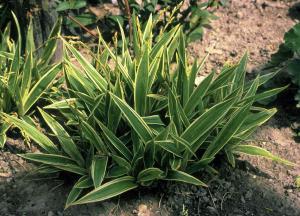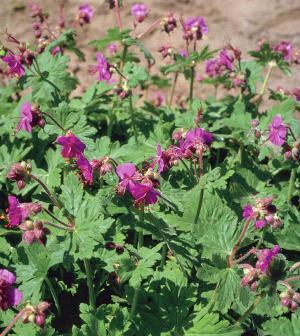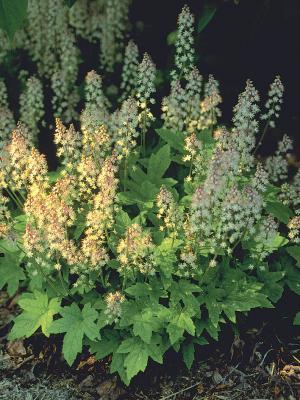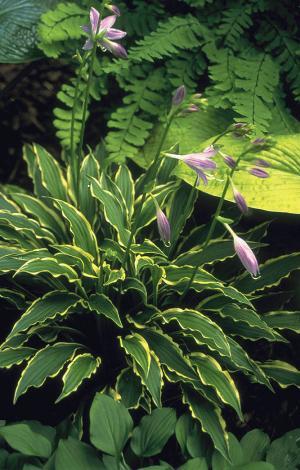To some gardeners, the idea of growing things in shade can be rather daunting.
-- Jane Taylor
By Theresa Forte
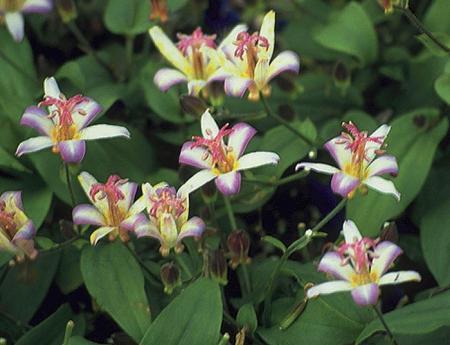 | |
| Tricyrtis hirta 'Togen' |
Several participants had purchased older homes with established gardens, while others were starting from scratch. The result of their efforts to date had been discouraging. The plants had not performed as expected.
When asked about their particular site, few could describe their own garden conditions. How many hours of sun did the garden enjoy? If mostly shade, was the shade created by tall buildings (permanently shady) or by neighbouring trees (allowing sunlight to filter through, especially in the spring)?
Was the soil sandy and well drained or humus-rich and moist? Do large trees absorb all available moisture? Or, was the garden located in a low spot where water collects and is slow to drain? These are just a few of the simple questions your customers should be able to answer before deciding which plants to purchase for their garden. Most gardeners are more apt to select anything in bloom from the displays, disregarding the ideal growing conditions required for success.
The key to success lies in selecting a great plant for the ideal location. The most common error is placing a sun-loving plant in shade (to wallow) or a shade-loving plant in full sun (to fry). Once you have spent time getting to know your specific garden conditions, you can confidently select plants that will thrive and prove to be a beautiful and wise investment in your garden.
Charming spring gardens
While visiting Toronto, I had the great pleasure of studying some of the older, established neighborhoods. Many of these homes are nestled beneath a canopy of mature trees. Majestic oak trees tower above the stately homes. A successive pruning of all lower branches was executed over the years, in an attempt to allow as much sunshine as possible to reach the gardens below. And what glorious gardens they are!
One of the secrets of enjoying a successful shade garden is to take advantage of the early spring season. There is no need to wait for summer to add colour to a shade garden; many early blooming spring bulbs and woodland perennials will provide a colourful show before the canopy of leaves returns.
|
Many of the older gardens were carpeted with Scilla, commonly known as bluebells. The gardener at one such home, had obviously given up the battle to maintain a lawn. The front garden was gently terraced using natural stone. A generous fieldstone walk welcomed visitors to enjoy the informal plantings of spring flowers, as they made their way to the formal main entrance. Several varieties of daffodils joyously heralded the glorious spring day, above a sea of gentian-blue flowers. In such a wooded neighbourhood, squirrels can present quite a challenge to gardeners, tulips being a preferred gourmet feast. However, daffodils are poisonous to squirrels and consequently are left alone. They should be planted in well-drained soil. According to Patrick Lima, "Daffodils are encouragingly easy to grow. True low-maintenance plants, they are cold-tolerant, insect-proof, healthy and enduring." Who could ask for more? Closer to the home itself, spring blooming shrubs such as forsythia, viburnum, rhododendron and lilac were preparing for their later spring performances. Elegant black cast-iron urns, situated on either side of the front steps added a formal touch. They featured seasonal displays of pussy-willow branches, crocus, grape hyacinth and early daffodils. Cars and pedestrians alike were slowing down to enjoy the garden's magical display of colour. It was a romantic garden for spring, but what happens when the bluebells and daffodils are finished blooming? The trick is to plant the bulbs among later sprouting herbaceous perennials. The emerging perennials will disguise the fading foliage of the bulbs. For longevity and health of the bulbs, it is essential that the foliage be allowed to die back naturally. This stage is necessary to feed the bulb for next year's blooms. In this particular garden, a blanket of Cotoneaster would cover the fading bluebells. Daylilies, perennial grasses and Siberian iris make great companions for daffodils, with their similar, strap-like foliage. Situate the perennials together in groups of three to five of the same plant. Place the daffodils eight to 10 inches from the crowns of the companion perennials, weaving them through the planting to create an informal grouping. None of the bulbs should be planted toward the front of the perennials, rather between and behind them so that the emerging foliage will completely hide that of the bulbs. Another successful marriage for shade gardens, combines Muscari, (grape hyacinth) and Alchemilla mollis, (lady's mantle). The grape hyacinth will bloom from April to early May. As the flowers fade, the delicate foliage of the lady's mantle emerges to form a blanket of delicately serrated, velvety leaves. These discreetly mask the fading grape hyacinth leaves. In early fall, the grape hyacinth offer fresh grassy foliage, which can appear untidy in the front of a border. The lady's mantle, having been cut back after blooming, will provide a luscious foliage cover once again.
Recommended perennials for shade
Tricyrtis (Japanese toad-lily)
Tiarella cordifolia 'Oakleaf' (Foamflower)
Carex siderostica 'Variegata'
(Sedge)
Hosta 'Stiletto'
Saxifragas x urbium 'Aureopunctata' (Golden London pride)
Geranium macrorrhizum (Bigroot cranesbill)
Luzula sylvatica (Greater wood rush) (My sincere thanks to John Valleau of Valleybrook Gardens for supplying the photography.) |
